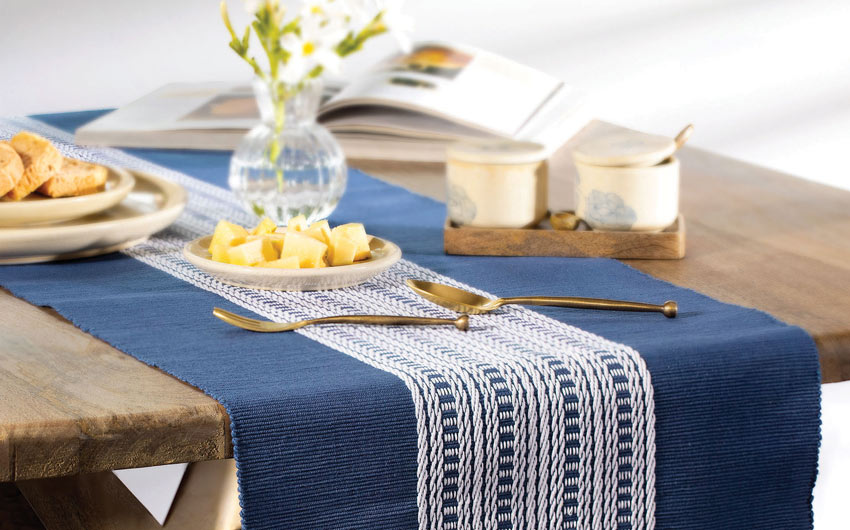How to Select the Perfect Table Runner for Your Dining Table
How to Select the Perfect Table Runner for Your Dining Table
Blog Article
Bed Linen Material Innovations: Discovering Modern Trends and Creative Applications in Style and Textile Industry
From lasting manufacturing methods to sophisticated weaving innovations, the development of linen is reshaping the landscape of the fabric sector. As we dive into the worlds of creative design applications and the appearance of linen blends and hybrid fabrics, a brand-new phase unfolds in which bed linen's role in future textile advancements takes facility stage.
Lasting Practices in Bed Linen Manufacturing
Sustainable techniques in linen production have actually ended up being increasingly essential in the textile industry's initiatives to minimize ecological impact and promote ethical sourcing approaches. Linen, a natural fiber originated from the flax plant, uses a variety of advantages such as breathability, longevity, and biodegradability. Nevertheless, conventional techniques of linen manufacturing can involve substantial water intake, pesticide usage, and energy-intensive processes.
To address these obstacles, numerous fabric suppliers are adopting lasting techniques throughout the bed linen production procedure. This consists of sourcing flax from organic farms that prevent dangerous chemicals and chemicals, carrying out water-efficient retting strategies to remove fibers from the flax stalks, and making use of green dyes and surfaces. Furthermore, some business are buying renewable resource resources to power their production facilities and decreasing waste with recycling and upcycling initiatives.
Technological Innovations in Bed Linen Weaving
With the growing focus on sustainable techniques in bed linen production, the fabric market is now witnessing a surge in technological improvements especially targeted at transforming the art of bed linen weaving. These technologies are reshaping the means linen fabrics are produced, using enhanced efficiency, high quality, and creative thinking in weaving methods.
Among the vital technological improvements in linen weaving is the combination of electronic looms. These innovative looms are furnished with software that permits complex and complex styles to be woven with precision. By digitizing the weaving procedure, producers can achieve better consistency and precision in their bed linen fabrics.
Moreover, innovations in yarn spinning modern technology have enabled the manufacturing of finer and even more resilient bed linen yarns - table cloths. This causes softer and smoother linen materials that preserve their top quality also after several usages and laundries
Additionally, the development of green dyeing procedures and surfaces for bed linen fabrics is getting grip. These sustainable methods not only reduce the environmental impact yet additionally satisfy the boosting consumer need for fairly created textiles.
Creative Design Applications for Bed Linen
Ingenious artistic methods are significantly forming the innovative design applications for linen in the fabric market. Linen's all-natural aesthetic allure and capability to mix with other textiles make it a preferred choice for creating one-of-a-kind garments and devices that provide to the eco mindful consumer.
Additionally, developers are explore bed linen in home style, using its sturdy and breathable nature to craft elegant home furnishings such as curtains, bed linen, and furniture. The texture and drape of linen bring a feeling of class and comfort to indoor areas, adding a touch of style to modern-day homes.

Bed Linen Blends and Crossbreed Fabrics
:max_bytes(150000):strip_icc()/__opt__aboutcom__coeus__resources__content_migration__brides__proteus__585bf60c786c7a9c62c877d2__11-a40aeea82c0a440282d07dadffc6a7d8.jpeg)
Hybrid textiles, on the other hand, take the idea of blending a step better by incorporating added components such as metallic strings, recycled materials, or conductive fibers. These cutting-edge fabrics not just broaden the layout opportunities but also introduce practical elements like conductivity, antimicrobial residential or commercial properties, or improved toughness. Crossbreed textiles are significantly being used in numerous markets, including fashion, interior decoration, and technical fabrics, where the demand for multifunctional products is on the rise.
Bed linen's Function in Future Fabric Innovations

In the world of future textile advancements, bed linen is anticipated to be a crucial player in the advancement of sophisticated practical fabrics. Scientists and developers are discovering methods to improve bed linen's integral qualities with technical improvements, such as including wise textiles, nanotechnology, and performance finishes. These technologies aim to raise linen's performance features, making it appropriate for a broader variety of applications, from activewear to protective apparel.
Additionally, the mix of linen with various other all-natural or artificial fibers opens limitless opportunities for developing unique fabrics with one-of-a-kind properties and functionalities. By leveraging bed linen's qualities and exploring innovative blends, the textile market is positioned to present interesting growths that cater to evolving customer needs and sustainability requirements.
Conclusion
Finally, the expedition of lasting techniques, technological advancements, creative layout applications, bed linen blends, and its function in future fabric advancements highlight the continual advancement of linen textile in the modern-day design and textile industry. With a focus on advancement and imagination, the versatility and eco-friendly nature of bed linen make it a beneficial product for makers and developers alike, leading the way for further helpful resources growths and developments in the field of fabrics.
As we dig into the realms of imaginative layout applications and the appearance of bed linen blends and hybrid fabrics, a new phase unravels in which linen's role in future fabric advancements takes facility stage.
Exploring the fusion of bed linen with other textiles has actually led to the introduction of cutting-edge blends and crossbreed fabrics in the contemporary textile industry. Bed linen blends supply an unique mix of the attributes of linen with those of other fibers, resulting in materials that possess enhanced properties such as increased longevity, improved draping, and decreased wrinkling.The development of bed linen blends and hybrid textiles has set the phase for Linen to play a pivotal duty check my source in driving future textile developments.In the realm of future textile advancements, bed linen is anticipated to be a key gamer in the development of innovative functional materials.
Report this page